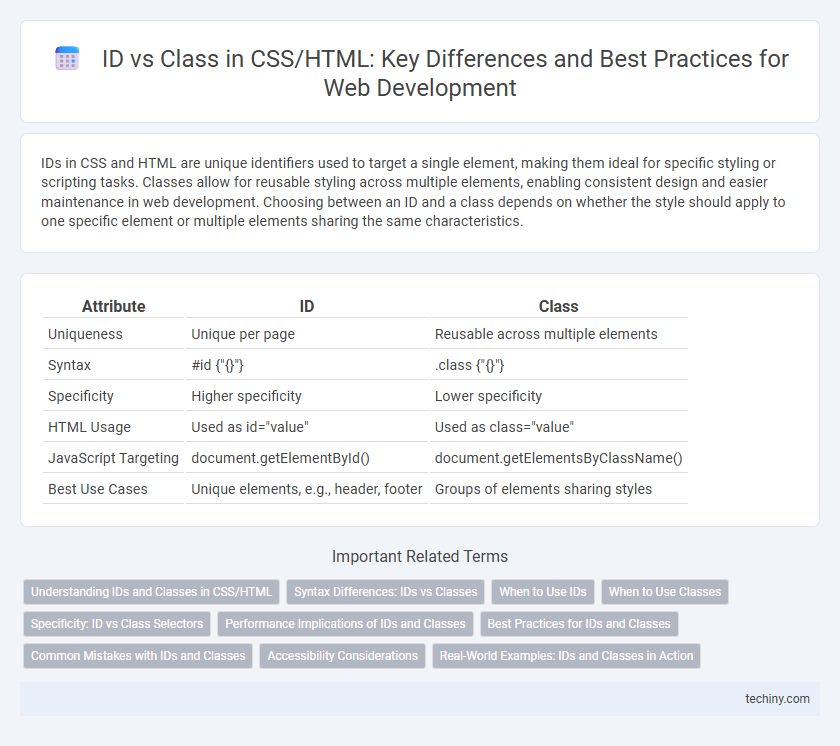IDs in CSS and HTML are unique identifiers used to target a single element, making them ideal for specific styling or scripting tasks. Classes allow for reusable styling across multiple elements, enabling consistent design and easier maintenance in web development. Choosing between an ID and a class depends on whether the style should apply to one specific element or multiple elements sharing the same characteristics.
Table of Comparison
| Attribute | ID | Class |
|---|---|---|
| Uniqueness | Unique per page | Reusable across multiple elements |
| Syntax | #id {"{}"} | .class {"{}"} |
| Specificity | Higher specificity | Lower specificity |
| HTML Usage | Used as id="value" | Used as class="value" |
| JavaScript Targeting | document.getElementById() | document.getElementsByClassName() |
| Best Use Cases | Unique elements, e.g., header, footer | Groups of elements sharing styles |
Understanding IDs and Classes in CSS/HTML
IDs in CSS/HTML serve as unique identifiers assigned to single elements, enabling precise styling and scripting through selectors prefixed with "#". Classes allow grouping multiple elements under the same name, facilitating reusable styles targeted by selectors with a "." prefix. Proper use of IDs and classes improves code maintainability and specificity management in web development.
Syntax Differences: IDs vs Classes
IDs in CSS and HTML use the hash symbol (#) for selectors and must be unique within a document, making them ideal for targeting a single element. Classes use the dot (.) syntax and can be assigned to multiple elements, facilitating shared styling across different parts of a webpage. The distinct syntax and uniqueness constraints of IDs versus the reusable nature of classes optimize their roles in web development for element identification and styling.
When to Use IDs
IDs in CSS and HTML should be used for uniquely identifying a single element on a webpage, ensuring specific styling or JavaScript functionality applies only to that one element. They are ideal for targeting elements that appear once per page, such as a navigation bar, footer, or unique section, providing faster selector performance compared to classes. Avoid using IDs for multiple elements to maintain valid HTML structure and avoid specificity conflicts in styling.
When to Use Classes
Classes in CSS are ideal for styling multiple elements that share common properties, promoting reusable and maintainable code. They enable consistent styling across a website by grouping elements without restrictions on uniqueness, unlike IDs which must be unique within a page. Using classes supports modular design approaches such as component-based development and frameworks like Bootstrap or Tailwind CSS.
Specificity: ID vs Class Selectors
ID selectors in CSS have higher specificity than class selectors, with an ID selector scoring 100 points compared to a class selector's 10 points in the specificity hierarchy. Using IDs can override styles applied by classes due to this specificity difference, making IDs suitable for unique elements requiring distinct styling. However, excessive reliance on IDs can reduce flexibility and maintainability, as classes provide reusable styling options for multiple elements.
Performance Implications of IDs and Classes
IDs in CSS provide faster performance due to their uniqueness, allowing browsers to quickly locate elements with document.getElementById(). Classes, while slightly slower because they can apply styles to multiple elements, enable greater flexibility and reusability in styling. Optimal web development balances the use of IDs for critical, singular elements and classes for broader style application to enhance rendering efficiency and maintainability.
Best Practices for IDs and Classes
IDs in CSS and HTML should be unique within a page, making them ideal for targeting single elements like headers or sections, while classes are reusable and best suited for styling multiple elements uniformly. Best practices recommend using IDs for JavaScript manipulation and specific element styling, whereas classes enhance flexibility by grouping elements with shared styles or behaviors. Proper separation improves code maintainability, performance, and scalability in web development projects.
Common Mistakes with IDs and Classes
Using IDs instead of classes for styling multiple elements is a common mistake that limits reusability and violates CSS best practices, as IDs must be unique within a document. Developers often confuse ID selectors (#) and class selectors (.), leading to specificity issues that cause unexpected rendering problems and complicate maintenance. Overusing IDs can also hinder scalability and flexibility in responsive web design, while properly utilized classes enable efficient grouping and consistent application of styles across elements.
Accessibility Considerations
IDs in CSS and HTML provide unique identifiers for elements, enabling precise targeting but can limit flexibility when applying styles or scripting for multiple components, which may impact accessibility if misused. Classes allow grouping of multiple elements under shared styles or behaviors, supporting consistent user experience and easier maintenance of accessible designs through reusable code patterns. Proper use of ARIA roles and semantic HTML alongside IDs and classes enhances content discoverability and keyboard navigation for users relying on assistive technologies.
Real-World Examples: IDs and Classes in Action
IDs in CSS/HTML uniquely identify a single element, commonly used for elements like navigation bars (#navbar) or headers (#header) to apply specific styles or scripts. Classes allow multiple elements to share the same styling, such as buttons (.btn) or cards (.card), enabling consistent design across a website. Real-world examples include using an ID for a unique footer section (#footer) and classes to style multiple product items (.product-item) in an e-commerce layout.
ID vs Class (in CSS/HTML) Infographic

 techiny.com
techiny.com